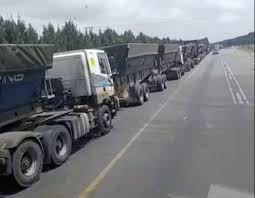South Africa’s biggest bulk export port, Richards Bay, is now struggling to cope with heavy truck traffic due to the ongoing collapse of the country’s rail system. According to reports, over 303,000 trucks used the port in the 2024 financial year. This is more than four times the number recorded ten years ago. On average, about 6,000 trucks now enter the port each week, creating serious congestion and pressure on infrastructure.
Richards Bay Port, located in KwaZulu-Natal province, is one of Africa’s most important ports for exporting bulk minerals such as coal and chrome. But due to the poor performance of South Africa’s rail system, many exporters have moved their cargo from rail to road. Businesses say they can no longer rely on the railways, so they now use trucks to move goods to the port. This shift has caused major problems for the port, which is no longer able to handle the growing number of trucks.
The situation has become so serious that roads around the port, especially the N2 highway and R34 route, are facing serious damage. The N2 was originally designed to carry only 200 trucks per day, but now, that number has increased by about 140 percent. The large volume of trucks is damaging the roads faster than they can be repaired, making driving conditions worse for everyone.
The Road Freight Association (RFA) and the Truckers Association of South Africa have both raised alarm about the crisis. They said the traffic is causing delays, raising the cost of business, and making it more dangerous for drivers. According to Gavin Kelly, the CEO of RFA, the lack of clear communication from port officials makes things worse. Truck drivers often don’t know when to enter or exit the port, leading to long queues and confusion on the roads.
In an attempt to manage the crisis, local authorities and Transnet, the state-owned logistics company in charge of rail and ports, have introduced temporary measures. These include setting up 24-hour traffic teams and creating holding areas for trucks along the R34 route. But many in the transport and export industries believe these are not lasting solutions. They are calling for real-time updates, improved access points, and a better port management system that can reduce waiting times and stop the long queues.
The economic impact of the crisis is now becoming more serious. Economists warn that delays at Richards Bay Port are pushing up freight charges and slowing down trade. With trucks sometimes waiting days to offload goods, exporters lose money and the country’s global competitiveness suffers. This affects both local businesses and international customers who depend on fast and reliable deliveries from South Africa.
Bulk mineral exports like coal and chrome are especially affected. Companies in the mining sector are now spending more money on road transport, which is more expensive and less efficient than using rail. If the rail system does not improve, experts fear that South Africa will continue to lose money and jobs in key sectors like mining, transport, and trade.
Transnet, under the leadership of CEO Michelle Phillips, says it is working to fix the rail network. However, many businesses believe not enough is being done to repair the damage already caused. They say that unless the government takes urgent and serious action, the logistics bottleneck at Richards Bay could grow worse.
With roads breaking down, trucks piling up, and no clear long-term solution in sight, the Richards Bay port congestion highlights a bigger problem in South Africa’s infrastructure and logistics system. Until the rail system is revived, truck transport will remain the only option for many exporters — even though it is damaging roads, slowing trade, and making life harder for everyone involved in the supply chain.
